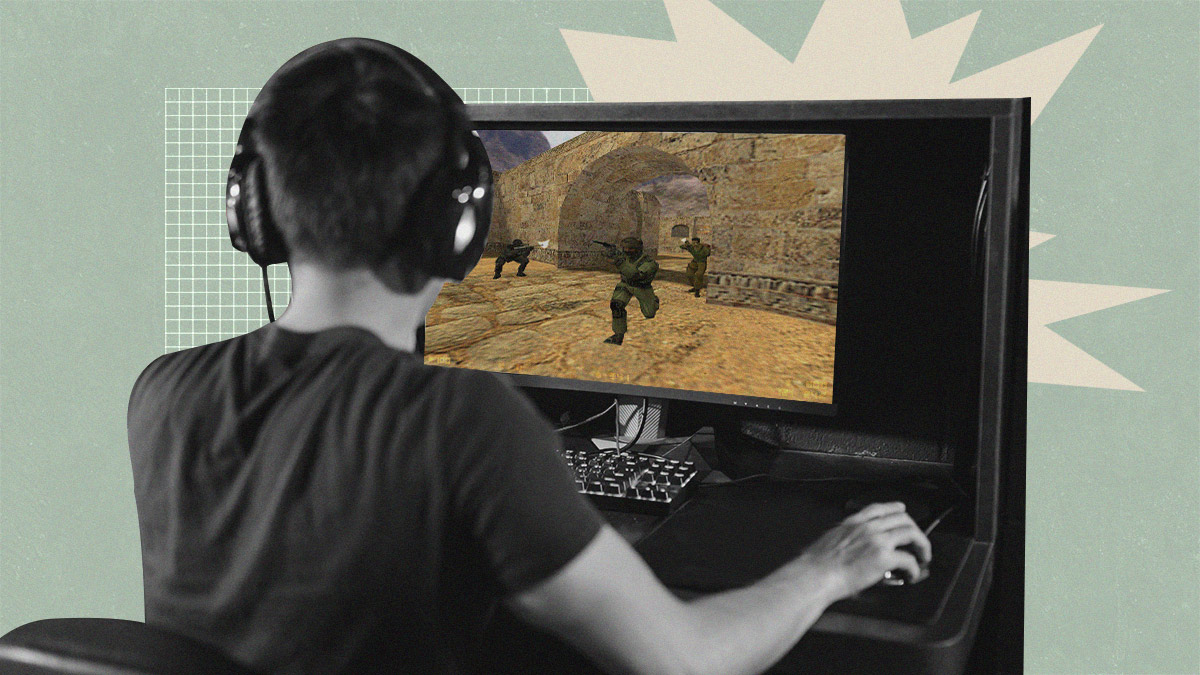Introduction
Welcome to the exciting world of online gaming in the year 2000! The new millennium brought with it significant advancements in technology, and the internet became a gateway to a virtual world of endless possibilities. Online gaming, once a niche pastime, began to gain traction and capture the imaginations of people from all walks of life.
In the early 2000s, online gaming experienced a surge in popularity, fueled by the increasingly accessible internet connections and the growing demand for interactive virtual experiences. Whether battling mythical creatures in a multiplayer online role-playing game (MMORPG), engaging in intense team-based battles in online first-person shooters, or strategizing to conquer virtual worlds in real-time strategy games, gamers were now able to connect with others from around the globe and share in immersive gaming experiences like never before.
The advent of high-speed internet connections revolutionized the online gaming landscape in 2000. Gamers could now enjoy smoother gameplay, reduced lag, and faster downloads and uploads, ushering in a new era of online gaming where the virtual worlds felt more realistic and engaging.
MMORPGs took center stage in online gaming during this time. These games allowed players to create and customize their own characters, explore vast digital worlds, and embark on epic quests with thousands of other players at any given time. Titles like EverQuest and Ultima Online provided players with a way to escape reality and immerse themselves in rich storylines and social interactions that made the gaming experience truly unique.
Online first-person shooters also gained popularity, offering intense multiplayer battles and competitive gameplay. Games like Counter-Strike and Quake III Arena allowed players to test their skills against opponents from around the world, showcasing reflexes and strategic thinking.
Strategy games saw a rise in popularity as well, with titles like StarCraft and Age of Empires II captivating players with their intricate gameplay and competitive multiplayer modes. Gamers could test their strategic thinking and decision-making skills in real-time battles, or collaborate with friends to build empires and conquer rivals.
While sports games had traditionally been limited to local multiplayer, online gaming broke down those barriers, allowing players to compete against opponents from anywhere in the world. This brought a new level of competitiveness and realism to sports gaming, enabling players to test their skills against a global community of virtual athletes.
But online gaming wasn’t just about hardcore gamers. The rise of casual online games, such as puzzle games and card games, provided a more accessible and lighthearted gaming experience for people of all ages. These games allowed players to jump in for a few quick rounds, making them perfect for relaxing and sociable gaming sessions.
In the year 2000, online gaming was about more than just the games themselves. It was a social experience, fostering connections and friendships among players. Online gaming communities and guilds emerged, providing players with a sense of belonging and camaraderie. Gamers could chat with each other in real-time, coordinate strategies, and form meaningful relationships with fellow enthusiasts who shared their passion for gaming.
However, online gaming in 2000 was not without its challenges and limitations. Internet connectivity issues, such as dropped connections and limited bandwidth, could occasionally disrupt the gaming experience. Furthermore, not everyone had access to high-speed internet, which limited the number of players able to fully participate in the online gaming revolution.
The year 2000 marked a turning point in the world of online gaming. It paved the way for the immersive and interconnected gaming experiences we enjoy today. With the advancements in technology and the ever-expanding online gaming market, it’s fascinating to see how far we’ve come and to imagine what the future holds for online gaming.
The Rise of Online Gaming
The turn of the millennium brought about a surge in the popularity of online gaming. As technology advanced and internet connectivity became more accessible, people began to explore the possibilities of virtual interactions and immersive gaming experiences. Online gaming, which was once a niche hobby, started to captivate a wider audience and reshape the gaming landscape.
One of the key factors contributing to the rise of online gaming was the increased availability of high-speed internet connections. Dial-up connections were still prevalent in the early 2000s, but broadband internet started to gain traction. This meant faster download and upload speeds, reduced lag, and smoother gameplay, all of which enhanced the online gaming experience.
Another crucial aspect was the development and improvement of gaming platforms and technologies. Console manufacturers like Sony, Microsoft, and Nintendo introduced online capabilities to their gaming systems, enabling players to connect with others around the world. This breakthrough allowed gamers to enjoy multiplayer experiences from the comfort of their homes, eliminating the need for local multiplayer or physically gathering in arcades.
The rise of online gaming was also fueled by the increasing demand for social interactions in the virtual space. People sought opportunities to connect with others, form communities, and share experiences, regardless of geographic boundaries. Online gaming provided a platform for like-minded individuals to come together, collaborate, and compete.
Furthermore, the variety and depth of online games expanded rapidly during this period. Players were no longer limited to single-player campaigns or local multiplayer matches. Online gaming offered a vast array of genres and game types, ranging from massive multiplayer online role-playing games (MMORPGs) like EverQuest and Ultima Online to fast-paced first-person shooters like Quake III Arena and Counter-Strike.
MMORPGs, in particular, gained significant popularity. These games allowed players to step into virtual worlds, create customized characters, and embark on epic quests alongside thousands of other players. The sense of immersion and community fostered in MMORPGs drew in a dedicated player base, eager to explore new realms and build lasting friendships.
Additionally, the rise of online gaming also brought forth a new era of competitive gameplay. Esports, organized competitions in online games, started to garner attention and recognition. Players now had the opportunity to showcase their skills and compete on a global stage, further fueling the fascination and growth of online gaming.
Overall, the rise of online gaming in the year 2000 was driven by advancements in technology and internet connectivity, along with the desire for social interactions and competitive gameplay. It opened up a world of endless possibilities, where gamers could connect with others, explore virtual realms, and experience collaborative and competitive gameplay on a scale never seen before.
Internet Speeds and Connections
The success and growth of online gaming in the year 2000 were closely tied to the advancements in internet speeds and connections. During this time, internet service providers were working hard to improve their infrastructure and offer faster and more reliable internet access to households around the world.
In the early 2000s, dial-up connections were still the most common way to access the internet. These connections had limited bandwidth and relatively slow speeds compared to what we have today. Gamers using dial-up had to contend with frequent disconnections, latency issues, and long download times. Despite these limitations, many still embraced online gaming and eagerly participated in the emerging gaming communities.
However, a significant turning point occurred as the adoption of broadband internet started to gain momentum. Broadband connections offered much higher data transfer rates and lower latency compared to dial-up. This meant that gamers could enjoy smoother gameplay, reduced lag, and faster downloads and uploads.
The increased speed and stability of broadband connections allowed for more immersive and enjoyable online gaming experiences. Players could engage in real-time battles, chat with fellow gamers, and explore virtual worlds seamlessly. The shift from dial-up to broadband created a paradigm shift in the gaming industry, creating a whole new level of excitement and possibilities for gamers.
Furthermore, the rise of broadband internet paved the way for the development of more intricate and complex online games. Developers were no longer constrained by slower connections and limited bandwidth. They could create expansive virtual worlds, filled with detailed graphics, immersive soundscapes, and seamless multiplayer functionality.
As broadband became more widespread, it also brought online gaming to new audiences. Previously, online gaming was accessible mainly to those with stable internet connections and the necessary resources to support it. However, the increased availability and affordability of broadband made it possible for a larger demographic to participate in online gaming, contributing to its growing popularity.
The year 2000 marked an important milestone in the advancement of internet speeds and connections. While it may not have reached the lightning-fast speeds we enjoy today, broadband internet set the foundation for the interconnected and immersive online gaming experiences we have come to expect.
It is worth noting that despite the improvements in internet speeds, some players still faced challenges due to geographical limitations or infrastructure disparities. Remote areas with limited access to broadband internet struggled to fully participate in the online gaming revolution. Nonetheless, the advancements in internet speeds and connections in the year 2000 laid the groundwork for the future growth and expansion of online gaming as internet technologies continued to evolve.
Multiplayer Online Role-Playing Games (MMORPGs)
The year 2000 witnessed a significant surge in the popularity of Multiplayer Online Role-Playing Games (MMORPGs). These games offered players the opportunity to immerse themselves in vast virtual worlds, interact with thousands of other players in real-time, and embark on epic quests and adventures.
MMORPGs revolutionized the gaming industry by creating immersive, social, and persistent online experiences. Players could create unique avatars, customize their appearance, and choose their character’s skills and abilities. Titles like EverQuest and Ultima Online pushed the boundaries of what was possible in online gaming, captivating players with their rich storytelling, expansive environments, and dynamic gameplay.
The social aspect of MMORPGs was a significant draw for players. Connecting with other players from around the world, forming friendships, and collaborating on quests and challenges enhanced the overall experience. In-game chat systems and guild systems allowed players to communicate, coordinate strategies, and build virtual communities.
Exploration played a fundamental role in MMORPGs. With vast open worlds to traverse, players could discover hidden treasures, encounter formidable monsters, and unravel the mysteries of the game’s lore. The sense of adventure and discovery kept players engaged and motivated to delve deeper into the virtual realms.
In addition to the exploration aspect, MMORPGs also offered rich character progression systems. Players could level up their characters, acquire new abilities and skills, and obtain powerful equipment through quests, battles, and looting. The constant sense of progression and growth provided a satisfying and rewarding experience.
The year 2000 saw the rise of several influential MMORPGs. EverQuest, released in 1999, continued to gain popularity and set the foundation for the genre. It offered a massive game world, diverse races and classes, intricate quests, and a vibrant community. Ultima Online, one of the earliest MMORPGs, remained a staple in the genre, providing players with a sandbox-like experience where they could explore and interact with a dynamic world shaped by player actions.
Other notable titles from this era included Asheron’s Call, Dark Age of Camelot, and Anarchy Online. Each game brought its own unique features and gameplay elements, captivating players with their distinct worlds and mechanics.
With the rise of MMORPGs, gaming companies began to explore subscription-based models to support and maintain these online worlds. Players paid a monthly fee to access the game servers, ensuring ongoing support, regular content updates, and server maintenance. This model allowed developers to continue expanding and enhancing the gaming experience, and players received a continuous stream of fresh content to explore.
MMORPGs in the year 2000 laid the foundation for the genre’s future growth. They set the standards for immersive storytelling, player interaction, and character progression, creating a benchmark for subsequent MMORPGs to strive towards.
The impact of MMORPGs on the gaming industry is still felt today. Many of the concepts and mechanics introduced in these early MMORPGs continue to shape and influence modern online gaming experiences, showcasing the enduring appeal and significance of the genre.
Online First-Person Shooters
In the year 2000, online first-person shooters (FPS) took the gaming world by storm. These adrenaline-pumping games allowed players to engage in intense, fast-paced battles with others from around the globe. With their immersive gameplay and competitive nature, online FPS games quickly became a favorite among gamers.
The rise of broadband internet and improved internet connections played a pivotal role in enabling online FPS experiences. Gamers could now connect to dedicated servers and experience minimal latency, providing a more responsive and seamless gaming experience. This shift from local multiplayer matches to online battles created a whole new level of excitement and competitiveness.
The online FPS genre saw several notable titles emerge in the year 2000. Games like Quake III Arena, Counter-Strike, and Unreal Tournament became household names among gamers. These games offered a variety of multiplayer modes, including team-based matches, free-for-all deathmatches, and objective-based gameplay, providing endless hours of thrilling action.
Quake III Arena, known for its fast-paced gameplay and slick movement mechanics, captivated players with its intense, skill-based battles. It featured diverse maps, a wide array of weapons, and customizable game modes, allowing players to tailor their experience to their preferences.
Counter-Strike, initially a mod for the popular game Half-Life, gained immense popularity in 2000. It introduced a realistic, tactical approach to FPS gameplay, where teamwork and communication were crucial for success. The game’s competitive nature and strategic depth made it a favorite among both casual and professional gamers, paving the way for the rise of esports.
Unreal Tournament, with its high-quality visuals and diverse arsenal of futuristic weapons, provided players with a fast-paced, action-packed FPS experience. The game featured a robust multiplayer mode with a variety of game types, including capture the flag, team deathmatch, and assault, satisfying the taste for different playstyles.
Online FPS games not only offered intense battles but also cultivated a sense of community among players. Gamers found themselves forming teams, joining clans, and competing in organized tournaments. The ability to communicate with teammates and opponents through voice chat or in-game messaging systems enhanced the social aspect of these games, fostering friendships and rivalries.
Moreover, online FPS games introduced new gameplay mechanics, such as skill-based matchmaking and ranking systems, that allowed players to compete against opponents of similar skill levels. This ensured balanced and competitive matches, increasing the overall enjoyment and longevity of the gaming experience.
The popularity of online FPS games in the year 2000 set the stage for the continued growth of the genre. Subsequent iterations and new titles introduced advancements in graphics, gameplay, and online infrastructure, further enhancing the immersive and competitive nature of online FPS gaming.
Overall, online first-person shooters in 2000 provided gamers with thrilling and engaging experiences. They showcased the potential of online multiplayer gaming, pushed the boundaries of technology, and laid the groundwork for the vibrant online FPS communities we see today.
Online Strategy Games
The year 2000 marked a significant rise in the popularity of online strategy games. These games provided players with the opportunity to showcase their tactical prowess, strategic thinking, and decision-making skills in competitive virtual environments. Online strategy games offered a unique and engaging gaming experience that captivated players worldwide.
The genre of online strategy games encompassed various subgenres, each with its own mechanics and gameplay elements. Real-time strategy (RTS) games and turn-based strategy (TBS) games were the primary categories, providing players with distinct approaches to strategic gameplay.
Real-time strategy games like StarCraft and Age of Empires II became iconic titles in the year 2000. These games offered fast-paced, dynamic gameplay where players had to manage resources, construct bases, amass armies, and engage in real-time battles against opponents. The multiplayer mode allowed players to compete against others online, testing their strategic thinking and multitasking abilities.
Online RTS games introduced a competitive aspect where players could showcase their skills in ranked matches and tournaments. The popularity of these games led to the emergence of professional esports players who became renowned for their strategic prowess and quick decision-making abilities.
Alongside RTS games, turn-based strategy games also gained traction in the online gaming scene. Titles like Civilization III and Heroes of Might and Magic III allowed players to take turns making decisions and executing actions. This slower-paced approach gave players more time to plan and strategize their moves, making each decision more impactful.
Online strategy games fostered a sense of competition and camaraderie among players. Online lobbies and matchmaking systems allowed players to connect with opponents of similar skill levels, ensuring balanced battles that would push them to their limits. The online communities surrounding these games provided platforms for players to share tips, strategies, and engage in discussions, fostering a vibrant and supportive environment.
The year 2000 also saw the emergence of browser-based strategy games. These games, such as Tribal Wars and Travian, allowed players to build and manage virtual civilizations or empires through a web browser. Browser-based strategy games offered a more accessible and casual experience, appealing to a broader audience.
The popularity of online strategy games in 2000 not only provided entertainment but also sparked an interest in historical events and strategic thinking. Players could engage with historical settings, commanding armies, managing economies, and making complex decisions that mirrored the challenges faced by real-world leaders.
The success of online strategy games in the year 2000 laid the foundation for continued innovation and growth within the genre. Subsequent years brought more advanced graphics, sophisticated gameplay mechanics, and improved online infrastructure, allowing for even more immersive and competitive strategic gaming experiences.
Overall, online strategy games in 2000 captivated players with their deep and strategic gameplay, competitive multiplayer modes, and vibrant online communities. They provided an avenue for players to showcase their tactical skills, engage in epic battles, and connect with fellow gamers who shared their passion for strategic thinking and decision-making.
Online Sports Games
The year 2000 marked a significant shift in the world of sports gaming with the rise of online sports games. These games allowed players to compete against opponents from around the world, removing geographical barriers and bringing a new level of competition and realism to the genre.
Prior to the advent of online sports games, most sports games were limited to local multiplayer or single-player experiences. Gamers would gather around a console or computer to compete against friends or AI-controlled opponents. However, with the advancements in internet connectivity and online gaming infrastructure, it became possible for players to experience the excitement of sports gaming against real opponents in real-time.
Online sports games provided a platform for players to showcase their skills and strategies in various sports disciplines. Popular sports such as football (or soccer), basketball, baseball, and hockey were among the most popular choices. Players could take control of their favorite teams or athletes and compete head-to-head against other players worldwide.
One of the key advantages of online sports games was the ability to compete in leagues or tournaments with other players. Gamers could join online leagues or tournaments, showcasing their abilities and vying for rank and recognition on leaderboards. The competitive nature of these games added an extra layer of intensity and motivation for players to improve their skills and outperform their opponents.
The online gaming communities surrounding sports games provided platforms for players to connect, discuss strategies, and form virtual teams. Many players formed online leagues or participated in online team play, collaborating with teammates to showcase coordinated strategies and teamwork. This added a social aspect to the gaming experience, allowing players to forge friendships and rivalries with like-minded individuals.
Online sports games in 2000 also introduced features to replicate real-world sports events and tournaments. Players could participate in virtual versions of popular competitions, such as the FIFA World Cup or the NBA Finals. This allowed gamers to experience the excitement and pressure of prestigious sporting events from the comfort of their own homes.
Furthermore, online sports games gave players the opportunity to test their skills against opponents of varying abilities and play styles. The matchmaking systems ensured fair and balanced matches, providing an enjoyable experience for players of all skill levels. This allowed beginners to learn from more experienced players, while skilled players could seek challenging opponents to push their limits.
Online sports games in 2000 played a significant role in expanding the reach and appeal of sports gaming. They brought the thrill and competitiveness of sports to a global stage, allowing players to connect and compete with others from different regions, cultures, and backgrounds. The online component provided a sense of community and camaraderie among sports gaming enthusiasts, enhancing the overall gaming experience.
As internet speeds and online infrastructure continued to improve, online sports games would go on to evolve and become increasingly realistic, immersive, and engaging. The foundation laid in 2000 paved the way for the development of more advanced online sports gaming experiences, further blurring the line between virtual sports and reality.
Online Casual Games
In the year 2000, the world of online gaming witnessed the rise of casual games. These games offered a more accessible and lighthearted gaming experience, appealing to a broader audience beyond traditional gamers. Online casual games provided quick, bite-sized entertainment that could be enjoyed by players of all ages and gaming abilities.
Casual games encompassed a wide range of genres, including puzzle games, card games, arcade games, and more. These games were designed to be easy to pick up and play, requiring minimal time commitment and offering instant gratification.
One of the factors contributing to the popularity of online casual games was their accessibility. These games could be played directly within web browsers, eliminating the need for extensive installations or high-end hardware. This made it possible for anyone with an internet connection to enjoy casual gaming without the barriers of expensive consoles or specialized gaming devices.
Puzzle games, such as Bejeweled and Tetris, were among the most popular online casual games of the time. These games challenged players’ problem-solving skills, quick thinking, and pattern recognition abilities. They offered simple mechanics and addictive gameplay, providing a satisfying sense of accomplishment when players cleared levels or achieved high scores.
Card games like Solitaire and Poker also found a new home in the online gaming space. Players could test their card-playing skills against opponents from around the world or enjoy a relaxing solo game. The online multiplayer aspect added a social dimension, allowing players to interact and compete with others, replicating the experience of playing with friends or in a casino.
Arcade-style games, inspired by classic arcade cabinets, brought back nostalgia and provided a dose of fun and entertainment. Games like Pac-Man, Space Invaders, and Galaga were recreated in online versions, allowing players to relive the arcade experience from the comfort of their own homes.
Online casual games often featured leaderboards, encouraging players to improve their scores and compete for the top spots. This added a competitive element to casual gaming, appealing to those seeking friendly competition and recognition for their achievements.
The year 2000 saw the emergence of online game portals and websites dedicated to hosting a wide variety of casual games. These platforms provided a convenient and centralized hub where players could discover and enjoy new games. Online casual gaming communities and forums also flourished, offering spaces for players to discuss game strategies, share tips, and connect with fellow casual gamers.
Online casual games served as a gateway to gaming and introduced many newcomers to the world of online gaming. Their accessibility, simplicity, and addictive nature provided a compelling and enjoyable experience for players seeking a quick gaming fix or a fun way to pass the time.
As technology advanced and the online gaming landscape evolved, casual games continued to thrive and adapt to new platforms and trends. They remain a popular choice for gamers of all ages and continue to provide a relaxed and enjoyable gaming experience.
Popular Online Games in 2000
The year 2000 saw the release of several groundbreaking and influential online games that captivated gamers worldwide. These games transcended boundaries, shaped the gaming landscape, and left a lasting impact on the industry. Let’s take a look at some of the most popular online games of that time.
EverQuest, released in 1999, continued to dominate the online gaming scene in 2000. This groundbreaking MMORPG provided players with a vast and immersive fantasy world to explore. With its deep lore, challenging quests, and social interactions, EverQuest attracted a dedicated player base that eagerly delved into its rich and evolving world.
Ultima Online, one of the earliest MMORPGs, remained a fan favorite in 2000. Developed by Richard Garriott, the game offered players unprecedented freedom to explore and shape the virtual world. Ultima Online emphasized player interactions and featured a robust player-driven economy, political systems, and PvP combat, setting the benchmark for future MMORPGs.
Quake III Arena, a highly popular online first-person shooter (FPS), captivated players with its fast-paced gameplay and intense multiplayer battles. With its robust online infrastructure and vibrant modding community, Quake III Arena provided players with endless hours of competitive and adrenaline-pumping gameplay.
Counter-Strike emerged as a standout online FPS game in 2000. Initially a mod for Half-Life, Counter-Strike gained immense popularity for its intense gameplay, realistic weapons, and focus on team-based tactics. The game’s competitive nature and thriving online community contributed to its status as one of the most influential online games of the year.
StarCraft, a real-time strategy (RTS) game developed by Blizzard Entertainment, continued to captivate players in 2000. With its engaging single-player campaign and deep multiplayer mechanics, StarCraft introduced players to the epic conflict between three unique factions. Its balanced gameplay and strategic depth made it a mainstay in the competitive gaming scene.
Diablo II, an action role-playing game (ARPG), took the online gaming world by storm with its addictive gameplay and cooperative multiplayer experience. Players could team up with friends or join public games to explore dark dungeons, defeat hordes of monsters, and search for powerful loot. Diablo II’s online component added a social dimension to the game, fostering collaboration and trading among players.
Other popular online games in 2000 included games like Age of Empires II, a real-time strategy game that allowed players to build civilizations and engage in epic battles, and The Sims, a life simulation game that captured the imagination of players with its virtual sandbox experience.
The popularity of these games in 2000 was a testament to their innovative gameplay, immersive worlds, and the ability to connect players from around the world. These games not only defined the year in online gaming but also set the stage for future advancements in online multiplayer experiences.
The impact of these games extended beyond the year 2000, as many of them continued to receive expansions, updates, and sequels, solidifying their status as pillars of the gaming industry. Even today, their influence can still be felt in the online gaming landscape, showcasing the enduring appeal and timeless nature of these iconic titles.
Social Interaction in Online Gaming
One of the defining features of online gaming in the year 2000 was the social aspect it brought to the gaming experience. Online gaming provided players with a platform for social interaction, connecting gamers from around the world and fostering communities and relationships that extended beyond the virtual realms.
Online gaming allowed players to communicate and collaborate in real-time, transcending geographical boundaries. In-game chat systems, voice chat, and messaging platforms enabled players to engage in conversations, coordinate strategies, and form friendships with fellow gamers. This social interaction added a whole new dimension to the gaming experience, making it a shared and communal activity.
Gaming communities and guilds emerged, offering players a sense of belonging and camaraderie. These communities provided spaces for players to connect with like-minded individuals, share gaming experiences, trade advice, and organize cooperative or competitive gameplay sessions. The sense of community fostered in online gaming became a significant motivating factor for players to continue exploring virtual worlds and engaging with the gaming community.
Within gaming communities, players often formed or joined guilds. Guilds were organized groups of players who collaborated and worked together to achieve common goals. Whether it was raiding dungeons in MMORPGs, competing in esports tournaments, or conquering territories in strategy games, guilds provided players with a support system and a sense of unity and purpose within the game.
Moreover, online gaming facilitated the development of friendships and relationships. Players could form strong connections with individuals they met in-game, bonding over shared interests and experiences. These friendships often extended beyond the virtual world, with players organizing meetups, forming online communities on forums or social media platforms, and even maintaining long-lasting friendships outside of gaming.
The social component of online gaming was not limited to hardcore gamers. Casual gamers and those less experienced with gaming found opportunities to connect with others as well. Online casual games, in particular, provided a more inviting and accessible entry point for people new to gaming, fostering a welcoming and inclusive social environment.
However, it is important to note that not all social interactions in online gaming were positive. Just as in any social setting, there were instances of toxic behavior, harassment, and trolling. Game developers and online gaming platforms worked to combat these issues by implementing reporting systems, moderation tools, and community guidelines to promote a safer and more inclusive gaming environment.
The year 2000 marked a turning point in how gaming brought people together. Online gaming provided an avenue for socialization, interaction, and the formation of lasting friendships. It created a sense of community where players could share their passion for gaming, connect with others who shared their interests, and partake in collaborative and competitive gameplay with like-minded individuals from around the world.
The social aspect of online gaming would continue to evolve and thrive, playing a significant role in shaping the modern online gaming landscape. Today, social interaction remains an integral part of the gaming experience, enriching the enjoyment and making online gaming a truly global and interconnected activity.
Gaming Communities and Guilds
In the year 2000, gaming communities and guilds became a central part of the online gaming experience. These communities provided players with a sense of belonging, camaraderie, and an avenue for social interaction within the virtual worlds they inhabited.
Gaming communities were formed by players who shared a common interest in specific games or gaming genres. These communities often revolved around online forums, fan websites, or dedicated social media groups. Players would gather to discuss game strategies, share tips and tricks, exchange stories, and form connections with other gamers who shared their passion.
These communities fostered a shared sense of enthusiasm and dedication, allowing players to find like-minded individuals who understood their gaming experiences and interests. They served as platforms for building friendships, organizing cooperative gameplay sessions, and even engaging in friendly competition within the gaming community.
Further strengthening the sense of community, guilds emerged as organized groups of players within specific games. Guilds provided players with a support system, a platform for collaboration, and a sense of identity within the virtual world.
Guild members frequently worked together to tackle challenging game content, such as raids or high-level dungeons in MMORPGs. They formed coordinated strategies, divided tasks, and relied on teamwork to overcome formidable in-game challenges. Guilds not only enhanced the gaming experience but also promoted social interaction and helped forge strong bonds among players.
Guilds often had leaders or officers who organized events, resolved conflicts, and maintained a sense of order and unity within the group. These leaders often set the tone and direction of the guild, creating an environment that encouraged collaboration, skill development, and inclusive socialization.
Within guilds, members would often communicate using in-game chat systems, voice chat platforms, or dedicated guild forums. This allowed for real-time coordination, planning, and socializing. Players would share tactics, offer guidance to less-experienced members, and celebrate successes together, further strengthening the sense of community within the guild.
The bond between guild members extended beyond the virtual world. Many guilds organized meetups, where members had the opportunity to gather in person, cementing their friendships formed through online gaming. These meetups facilitated face-to-face connections and created lasting memories for guild members.
Gaming communities and guilds proved to be essential aspects of the online gaming experience in 2000. They provided players with a supportive and social environment, allowing them to connect with others, form lasting friendships, and feel a sense of belonging within the virtual world.
These communities and guilds also played a vital role in the longevity of online games. They created a sense of loyalty, encouraging players to continue playing and engaging with the game content, knowing they were part of a larger community that shared their passion.
The concept of gaming communities and guilds in 2000 set the stage for future advancements in multiplayer gaming interactions. The social aspects of gaming would continue to evolve and thrive, becoming integral components of the modern online gaming landscape.
Challenges and Limitations
Despite the exciting advancements and growth in online gaming in the year 2000, there were also a number of challenges and limitations that players and developers faced. These challenges influenced the experiences and opportunities available to gamers during this time.
One of the primary challenges was related to internet connectivity. While broadband internet began to emerge, it was not yet accessible to everyone. Many gamers were still reliant on dial-up connections, which had slower speeds and limited bandwidth. This often resulted in issues such as high latency, frequent disconnections, and longer download times. These connectivity limitations impacted the overall gaming experience, causing delays, disruptions, and frustration for players.
The infrastructure surrounding online gaming was not as robust as it is today. Game servers sometimes experienced instability, which could result in intermittent downtime or loss of progress for players. Technical glitches, bugs, and server crashes were not uncommon, causing temporary disruptions to gameplay and creating frustrations for gamers.
Another limitation was the relatively small player capacity in online games at that time. Servers could only handle a limited number of players simultaneously. This meant that players sometimes had to wait in queues to access popular games or encounter restrictions on the number of players that could participate in certain activities or events.
In addition, online gaming required financial resources. Many online games came with monthly subscription fees, which could be a barrier for some players, especially younger gamers or those with limited financial means. The costs of maintaining an internet connection and purchasing gaming hardware were additional expenses that some players needed to consider.
Social issues also arose within online gaming, with instances of toxic behavior, harassment, and cheating. While game developers and platform providers took steps to address these issues, they remained persistent challenges that detracted from the overall enjoyment and inclusivity of the gaming experience.
Furthermore, online gaming in 2000 had limited cross-platform compatibility. Most online games were designed for specific platforms like PC or console, and players were often restricted to gaming within their chosen platform. This meant that players might miss out on the opportunity to connect and play with friends who used different gaming platforms.
Despite these challenges and limitations, gamers in 2000 were eager to embrace online gaming. They saw the potential and possibilities that emerged as technology continued to advance. These challenges highlighted areas for improvement and drove innovation within the gaming industry, setting the stage for future enhancements and developments in online gaming experiences.
The challenges faced in 2000 provided valuable lessons for developers and contributed to the evolution and growth of the online gaming landscape. Over time, these challenges would be addressed and overcome, leading to more stable, accessible, and immersive gaming experiences.
The Future of Online Gaming
The year 2000 marked a turning point in the evolution of online gaming, setting the stage for the future of this rapidly growing industry. As we look ahead, it is clear that online gaming will continue to push boundaries and reshape the way we play and interact with virtual worlds.
Advancements in technology will play a pivotal role in shaping the future of online gaming. As internet speeds increase and connectivity becomes more accessible, players can expect even more seamless and immersive experiences. The widespread adoption of high-speed internet, such as fiber optic connections, will minimize latency and provide smoother gameplay for players around the globe.
Furthermore, the development of cloud gaming technology holds promise for the future of online gaming. Cloud gaming allows players to stream games directly to their devices, eliminating the need for powerful hardware and enhancing accessibility. This shift towards cloud-based gaming could potentially expand the player base and introduce gaming to new demographics.
The rise of virtual reality (VR) and augmented reality (AR) technologies will revolutionize the online gaming experience. VR headsets and equipment will immerse players in virtual worlds, enabling them to interact with games in unprecedented ways. AR will bring virtual elements into the real world, blurring the boundaries between the physical and digital realms. These technologies will create new possibilities for social interactions, gameplay mechanics, and storytelling.
The integration of artificial intelligence (AI) in online gaming will also transform the player experience. AI-powered NPCs (non-player characters) will become more intelligent and responsive, providing more realistic and engaging interactions. AI algorithms will personalize gaming experiences, adapting gameplay to individual player preferences and creating dynamic and constantly evolving virtual worlds.
Esports will play an increasingly significant role in the future of online gaming. Professional competitive gaming will continue to grow, attracting larger audiences and generating more revenue. Esports tournaments will become even more prominent, offering players the opportunity to compete for substantial prize pools. The integration of streaming platforms and enhanced spectator experiences will make esports more accessible and engaging for viewers worldwide.
Cross-platform play will become more common, allowing players to connect and play with friends regardless of their chosen gaming platform. The barriers between console, PC, and mobile gaming will continue to diminish, providing a more inclusive and interconnected gaming experience.
Social interactions will continue to evolve in the future of online gaming. Virtual reality social platforms and social networks within games will enable players to connect, communicate, and collaborate with others on a deeper level. Communities and guilds will remain an essential aspect, fostering friendships and providing a sense of belonging within the gaming world.
As online gaming continues to evolve, players can expect more immersive storytelling, photorealistic graphics, and captivating gameplay mechanics. Developers will continue to push creative boundaries, exploring new genres and concepts, and delivering unique experiences that cater to the diverse interests and preferences of players.
The future of online gaming is filled with endless possibilities. As technology advances, the industry will continue to transform and surprise us. From advanced multiplayer experiences to truly immersive virtual reality worlds, the future of online gaming promises to be an exciting and ever-evolving journey for gamers around the world.
Conclusion
The year 2000 marked a crucial period in the history of online gaming. Advancements in technology and internet connectivity paved the way for immersive and interconnected gaming experiences that captivated players worldwide. From the rise of MMORPGs and online first-person shooters to the expansion of online sports and casual games, the landscape of online gaming transformed dramatically.
Online gaming in 2000 brought people together, fostering social interactions, and creating vibrant gaming communities and guilds. Players connected with fellow gamers, formed friendships, and collaborated in pursuit of shared goals. The social aspect of online gaming enriched the gaming experience and fostered a sense of belonging within the virtual worlds.
While there were challenges and limitations, such as internet connectivity issues and technical difficulties, these obstacles spurred innovation and led to advancements in online infrastructure. As the gaming industry continued to evolve, developers sought solutions to provide players with smoother gameplay, faster and more stable connections, and improved social features.
The future of online gaming promises even more exciting possibilities. Advancements in technology, such as cloud gaming, virtual reality, augmented reality, and artificial intelligence, will reshape the online gaming experience. Players can look forward to more immersive graphics, personalized gameplay, and innovative social interactions.
The rise of esports and the growing popularity of competitive gaming will further establish online gaming as a prominent form of entertainment, attracting larger audiences and generating new opportunities for players. The inclusivity brought by cross-platform play will connect gamers across different devices and further enhance the social aspect of online gaming.
As we move forward, the online gaming industry will continue to evolve, providing unparalleled experiences, fostering connections among players, and pushing the boundaries of what is possible in virtual worlds. The year 2000 was just the beginning of a remarkable journey that has shaped and will continue to shape the world of online gaming.

























